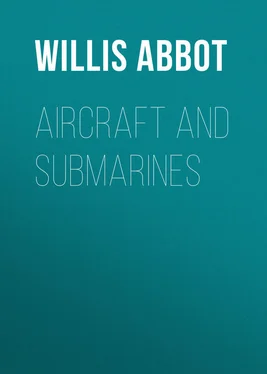Willis Abbot - Aircraft and Submarines
Здесь есть возможность читать онлайн «Willis Abbot - Aircraft and Submarines» — ознакомительный отрывок электронной книги совершенно бесплатно, а после прочтения отрывка купить полную версию. В некоторых случаях можно слушать аудио, скачать через торрент в формате fb2 и присутствует краткое содержание. Жанр: foreign_antique, foreign_prose, на английском языке. Описание произведения, (предисловие) а так же отзывы посетителей доступны на портале библиотеки ЛибКат.
- Название:Aircraft and Submarines
- Автор:
- Жанр:
- Год:неизвестен
- ISBN:нет данных
- Рейтинг книги:4 / 5. Голосов: 1
-
Избранное:Добавить в избранное
- Отзывы:
-
Ваша оценка:
- 80
- 1
- 2
- 3
- 4
- 5
Aircraft and Submarines: краткое содержание, описание и аннотация
Предлагаем к чтению аннотацию, описание, краткое содержание или предисловие (зависит от того, что написал сам автор книги «Aircraft and Submarines»). Если вы не нашли необходимую информацию о книге — напишите в комментариях, мы постараемся отыскать её.
Aircraft and Submarines — читать онлайн ознакомительный отрывок
Ниже представлен текст книги, разбитый по страницам. Система сохранения места последней прочитанной страницы, позволяет с удобством читать онлайн бесплатно книгу «Aircraft and Submarines», без необходимости каждый раз заново искать на чём Вы остановились. Поставьте закладку, и сможете в любой момент перейти на страницу, на которой закончили чтение.
Интервал:
Закладка:
Neither Great Britain nor the United States has reason to be proud of the attitude of its government towards the inventors who were struggling to subdue the air to the uses of man. Nor has either reason to boast much of its action in utterly ignoring up to the very day war broke that aid to military service of which Lord Kitchener said, "One aviator is worth a corps of cavalry." It will be noted that to get its first effective dirigible Great Britain had to rely upon popular subscriptions drummed up by a newspaper. That was in 1909. To-day, in 1917, the United States has only one dirigible of a type to be considered effective in the light of modern standards, though our entrance upon the war has caused the beginning of a considerable fleet. In aviation no less than in aerostatics the record of the United States is negligible. Our country did indeed produce the Wright Brothers, pioneers and true conquerors of the air with airplanes. But even they were forced to go to France for support and indeed for respectful attention.
So far as the development of dirigible balloons is concerned there is no more need to devote space to what was done in England and the United States than there was for the famous chapter on Snakes in Iceland.
CHAPTER IV
THE COUNT VON ZEPPELIN
The year that witnessed the first triumphs of Santos-Dumont saw also the beginning of the success of his great German rival, the Count von Zeppelin. These two daring spirits, struggling to attain the same end, were alike in their enthusiasm, their pertinacity, and their devotion to the same cause. Both were animated by the highest patriotism. Santos-Dumont offered his fleet to France to be used against any nation except those of the two Americas. He said: "It is in France that I have met with all my encouragement; in France and with French material I have made all my experiments. I excepted the two Americas because I am an American."
Count Zeppelin for his part, when bowed down in apparent defeat and crushed beneath the burden of virtual bankruptcy, steadily refused to deal with agents of other nations than Germany – which at that time was turning upon him the cold shoulder. He declared that his genius had been exerted for his own country alone, and that his invention should be kept a secret from all but German authorities. A secret it would be to-day, except that accident and the fortunes of war revealed the intricacies of the Zeppelin construction to both France and England.
Santos-Dumont had the fire, enthusiasm, and resiliency of youth; Zeppelin, upon whom age had begun to press when first he took up aeronautics, had the dogged pertinacity of the Teuton. Both were rich at the outset, but Zeppelin's capital melted away under the demands of his experimental workshops, while the ancestral coffee lands of the Brazilian never failed him.
Of the two Zeppelin had the more obstinacy, for he held to his plan of a rigid dirigible balloon even in face of its virtual failure in the supreme test of war. Santos-Dumont was the more alert intellectually for he was still in the flood tide of successful demonstration with his balloons when he saw and grasped the promise of the airplane and shifted his activities to that new field in which he won new laurels.
Zeppelin won perhaps the wider measure of immediate fame, but whether enduring or not is yet to be determined. His airships impressive, even majestic as they are, have failed to prove their worth in war, and are yet to be fully tested in peace. That they remain a unique type, one which no other individual nor any other nation has sought to copy, cannot be attributed wholly to the jealousy of possible rivals. If the monster ship, of rigid frame, were indeed the ideal form of dirigible it would be imitated on every hand. The inventions of the Wrights have been seized upon, adapted, improved perhaps by half a hundred airplane designers of every nation. But nobody has been imitating the Zeppelins.
That, however, is a mere passing reflection. If the Zeppelin has not done all in war that the sanguine German people expected of it, nevertheless it is not yet to be pronounced an entire failure. And even though a failure in war, the chief service for which its stout-hearted inventor designed it, there is still hope that it may ultimately prove better adapted to many ends of peace than the airplanes which for the time seem to have outdone it.
Stout-hearted indeed the old Luftgraaf – "Air Scout" – as the Germans call him, was. His was a Bismarckian nature, reminiscent of the Iron Chancellor alike physically and mentally. In appearance he recalls irresistibly the heroic figure of Bismarck, jack-booted and cuirassed at the Congress of Vienna, painted by von Werner. Heir to an old land-owning family, ennobled and entitled to bear the title Landgraf , Count von Zeppelin was a type of the German aristocrat. But for his title and aristocratic rank he could never have won his long fight for recognition by the bureaucrats who control the German army. In youth he was anti-Prussian in sentiment, and indeed some of his most interesting army experiences were in service with the army of South Germany against Prussia and her allied states. But all that was forgotten in the national unity that followed the defeat of France in 1872.
Before that, however, the young count – he was born in 1838 – had served with gallantry, if not distinction, in the Union Army in our Civil War, had made a balloon ascension on the fighting line, had swum in the Niagara River below the falls, being rescued with difficulty, and together with two Russian officers and some Indian guides had almost starved in trying to discover the source of the Mississippi River – a spot which can now be visited without undergoing more serious hardships than the upper berth in a Pullman car.
It was at the siege of Paris that Zeppelin's mind first became engaged with the problem of aërial navigation. From his post in the besieging trenches he saw the almost daily ascent of balloons in which mail was sent out, and persons who could pay the price sought to escape from the beleaguered city. As a colonel of cavalry, he had been employed mainly in scouting duty throughout the war. He was impressed now with the conviction that those globes, rising silently into the air, above the enemy's cannon shot and drifting away to safety would be the ideal scouts could they but return with their intelligence. Was there no way of guiding these ships in the air, as a ship in the ocean is guided? The young soldier was hardly home from the war when he began to study the problem. He studied it indeed so much to the exclusion of other military matters that in 1890 the General Staff abruptly dismissed him from his command. They saw no reason why a major-general of cavalry should be mooning around with balloons and kites like a schoolboy.
The dismissal hurt him, but deterred him in no way from the purpose of his life. Indeed the fruit of his many years' study of aeronautic conditions was ready for the gathering at this very moment. On the surface of the picturesque Lake Constance, on the border line between Germany and Switzerland, floated a huge shed, open to the water and more than five hundred feet long. In it, nearing completion, floated the first Zeppelin airship.
In the long patient study which the Count had given to his problem he had reached the fixed conclusion that the basis of a practical dirigible balloon must be a rigid frame over which the envelope should be stretched. His experiments were made at the same time as those of Santos-Dumont, and he could not be ignorant of the measure of success which the younger man was attaining with the non-rigid balloon. But it was a fact that all the serious accidents which befell Santos-Dumont and most of the threatened accidents which he narrowly escaped were fundamentally caused by the lack of rigidity in his balloon. The immediate cause may have been a leaky valve permitting the gas to escape, or a faulty air-pump which made prompt filling of the ballonet impossible. But the effect of these flaws was to deprive the balloon of its rigidity, cause it to buckle, throwing the cordage out of gear, shifting stresses and strains, and resulting in ultimate breakdown.
Читать дальшеИнтервал:
Закладка:
Похожие книги на «Aircraft and Submarines»
Представляем Вашему вниманию похожие книги на «Aircraft and Submarines» списком для выбора. Мы отобрали схожую по названию и смыслу литературу в надежде предоставить читателям больше вариантов отыскать новые, интересные, ещё непрочитанные произведения.
Обсуждение, отзывы о книге «Aircraft and Submarines» и просто собственные мнения читателей. Оставьте ваши комментарии, напишите, что Вы думаете о произведении, его смысле или главных героях. Укажите что конкретно понравилось, а что нет, и почему Вы так считаете.












